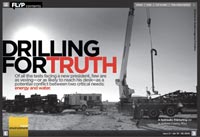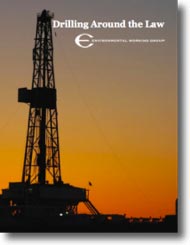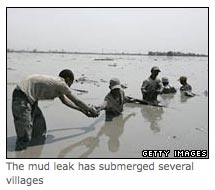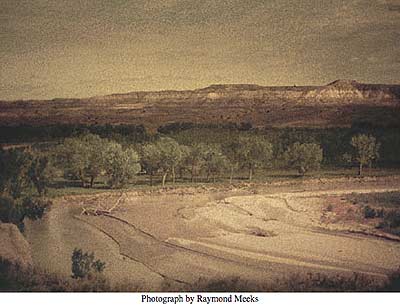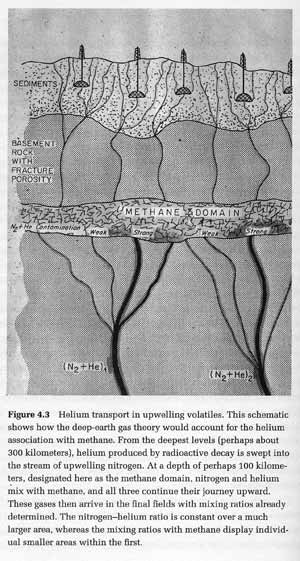Biblio
Abrahm Lustgarten. Flypmedia. Issue 21. January 16-29, 2009. "Drilling for Truth". Page 11.
Includes photos, graphics and videos.
Experimental Flash based interactive online magazine. Last updated Fall 2009. On April 19, 2010, Flyp announced that it will close.
See: Drilling Wastewater Disposal Options in N.Y. Report Have Problems of Their Own - ProPublica
Dusty Horwitt. (2009). "Drilling Around the Law Report." Environmental Working Group. 24 pages.
Contains extensive bibliography.
Companies that drill for natural gas and oil are skirting federal law and injecting toxic petroleum distillates into thousands of wells, threatening drinking water supplies from Pennsylvania to Wyoming. Federal and state regulators, meanwhile, largely look the other way.
--The mission of the Environmental Working Group (EWG) is to use the power of public information to protect public health and the environment. EWG is a 501(c)(3) non-profit organization, founded in 1993 by Ken Cook and Richard Wiles. Includes the EWG Action Fund, a 501(c)(4) organization that advocates on Capitol Hill for health-protective and subsidy-shifting policies.
Natural gas drilling in the Marcellus Shale Formation is threatening our health, and our water quality. Local resident gives her account of drilling in her community.
Daniel Gilbert. "Underfoot, Out of Reach: A series on the conflicts over Southwest Virginia's natural gas wealth." Virginia Tri-Cities.com. (online).
Beneath the surface of seven Southwest Virginia counties lie pools of natural gas worth more than a billion dollars a year. Some of this gas belongs to landowners forced by the state to lease their mineral rights to private energy corporations to develop. But instead of putting royalties into the pockets of mineral owners, the state funnels thousands of dollars every month into an escrow fund that royalty owners cannot monitor or access without clearing enormous legal hurdles.
While the system has vastly expanded production of natural gas in Virginia, it has devoted scant resources to ensuring that companies make the required payments into escrow, which in recent years has ballooned to more than $24 million. The result is that companies can produce gas for years without ever filing the necessary paperwork for royalties to be escrowed, and virtually no one notices that hundreds of individual accounts in escrow each month receive no deposits even though the corresponding gas wells are producing gas, a Bristol Herald Courier investigation finds.
To view the special program "The Paper that Made a Difference", produced by WJHL 11Connects, click here for part one, and here for part two of the program.
Articles in this series:
Part Three: The Virginia Supreme Court Weighs In
Part Four: Coal Goes on the Offensive
Part Five: From Crisis to Sustained Loss
Part Six: What is Missing from Escrow?
Part Seven: An Audit Long Delayed
Part Eight: Sue, Split or Do Nothing
Dig Deeper:Resources and links for more information
Do I have money in escrow? How to use our database and determine if you may have money in escrow.
View the members of and contact information for the Virginia Gas and Oil Board
Graphics:
Hydraulic Fracturing
Bristol Herald Courier
How Forced Pooling works
Search our Database for information on escrow accounts, with balances each month, current to March 2010.
See: Tom Vanderbilt. "Paper Trail." Time. Feb. 14, 2011.
Filmmaker Josh Fox of WaterUnderAttack.Com shows America how to speak truth to power, and leads us in the required revolution. "I know this is a farce, " he tells DEC at the public hearing they are required to do before shoving this crap down our throats. "You didn't listen to us before and you probably won't listen to us again. But we are willing to engage in civil disobedience."
See Gasland Trailer and See PBS interview with filmmaker Josh Fox.
See: Drilling Isn't Safe.
"Across vast regions of the country, gas companies are using a technology called hydraulic fracturing to produce natural gas from previously untapped beds of shale."
Fred R. Conrad/The New York TimesEnvironmental concern about hydraulic fracturing is creating political obstacles for gas drilling companies.
The most immediate hazard from the national drilling bonanza, it is clear, involves contamination of residential drinking water wells by natural gas. In Bainbridge, Ohio, an improperly drilled well contaminated groundwater in 2007, including the water source for the township’s police station, according to a complaint filed this year. After building to high pressures, gas migrated through underground faults, and blew up one house.
Here in Dimock, about 30 miles north of Scranton, Pa., 13 water wells, including that of Ms. Switzer, were contaminated by natural gas. One of the wells blew up.
If You Give Up, They Give Up - Stop Global Warming.
A dark, moody animation that children may not like to watch. A monkey, polar bear and kangaroo kill themselves because their world is ruined. TV Spot created by McCann Erickson Portugal for Quercus - National Association for Nature Conservation.
Produced by Seagulls Fly São Paulo.
See: The Tragedy of the Commons
See: Global Warming
See: Global Warming Frequently Asked Questions
See: Polar Bears (video)
See: Train (video)
See: Futurism Now (blog)
BBC. January 24, 2007. A mud flow that has displaced thousands of Indonesians was most probably caused by gas drilling, scientists say.
See: Davies, R. J, R. E Swarbrick, R. J Evans, and M. Huuse. 2007. "Birth of a mud volcano: East Java, 29 May 2006." GSA Today 17, no. 2: 4–9.
See below: Hardiyan Digwiyono. (2006). "Children in the Hot Mud Volcanoes". YouTube.
Watch the related videos that follow this one minute film.
"It is estimated that more than 5 million gallons of water per day are used in fracturing operations." ( p. 26 of 34. )
This 2006 Powerpoint may represent the only scholarly study found to date that indicates an accurate estimate of the amount of water used per day in hydrofracking. Further research into this estimated amount is required.
Presented at “The Future of Desalination in Texas,” Global Petroleum Research Institute, Texas A&M University, College Station, Texas, Aug. 6-8, 2006.
Powder Keg
The gas industry has been busy in Wyoming's prairies and grasslands, building thousands of miles of roads and sinking more than 10,000 wells in the past three years. But in the Powder River basin, ranchers are joining environmentalists to try to still the drills.
See: C-Span Book TV Oct. 2, 2004. Bushwacked: Life in George W. Bush's America. Chapter: "Dick, Dubya, and Wyoming Methane." (152)
Thomas Gold (1920-2004), Cornell astronomer and brilliant scientific gadfly.
The Abiogenic Theory of Petroleum Formation
Editor's Note: If we bust the myths about global warming and fossil fuels - the growing scarcity of our oil supply, and can replant lots of trees, by Freeman Dyson's estimates, a trillion, to remove all the carbon dioxide from the atmosphere now, with a lot more needed by 2050, as India, China, Brazil, etc. industrialize; then we only have to worry about methane from gas flares, and the melting of the tundra permafrost to prevent humanity from reaching the "tipping-point" of our destruction.
The Earth will undoubtedly survive, but we won't. Global Warming must be addressed by all governments, NGO's, citizen activists, and corporations. Drilling Isn't Safe. (Neil Zusman, 2010-11-14.)
Deep within the earth's crust there exists a second biosphere, composed of very primitive heat-loving bacteria and containing perhaps more living matter than is present on the earth's surface...
...Gold joins the deep hot biosphere argument to another, perhaps even more controversial theory for which he has marshalled evidence: that so-called fossil fuels originate not from compressed biological matter at all but from deep within the earth, present there since the planet's formation, long before our oxygen-rich surface biosphere came into existence.
The pattern of petroleum deposits and the mix of elements associated with them around the world, the dramatic results of a Swedish drilling project (1990) in non-sedimentary rock, and indications that some petroleum reserves are refilling - this is some of the evidence that supports Gold's thesis and cannot be adequately accounted for by conventional theories.
The implications of Gold's views are no less far-reaching than the theories behind them. The deep hot biosphere and deep-earth gas theories shed light on the nature of earthquakes, they suggest that reservoirs of petroleum and certain metal ores are much vaster (though not necessarily more accessible) than generally claimed, and they help to answer two of the most profound mysteries of the biological sciences: the origins of life on earth and the prospects of extraterrestrial life.
Did life develop from the deep hot biosphere? Are Mars and other planets as lifeless as they seem, or might they too be found to contain deep hot biospheres, if only scientists would look below the surface. --from the book jacket, 1999 edition.
Chapter 4. Evidence for Deep-Earth Gas
Chapter 5. Resolving the Petroleum Paradox
Chapter 6. The Siljan Experiment
Schematic image showing how the deep-earth gas theory would account for the helium association with methane (p. 76). Perhaps drilling deeper would make hydraulic fracturing and mountain-top removal unnecessary.
Gold's book has a Foreword by Freeman Dyson who is among the signatories of a letter to the UN criticizing the IPCC. He has argued against the ostracization of scientists whose views depart from the acknowledged mainstream of scientific opinion on climate change, stating that "heretics" have historically been an important force in driving scientific progress."
Heretics who question the dogmas are needed... I am proud to be a heretic. The world always needs heretics to challenge the prevailing orthodoxies."
See: Nicholas Davidoff. NYT. 2009. "The Civil Heretic".
See: Freeman Dyson. Heretical Thoughts About Science and Society. Edge | The Third Culture. Aug. 8, 2007.
See: Kellesidis, V.C. (2009). Challenges for very deep oil and gas drilling-will there ever be a depth limit? Athens, Greece: 3rd AMIREG International Conference (2009): Assessing the Footprint of Resource Utilization and Hazardous Waste Management.
Of course, we find oil ‘where it is’, where it has remained for ages, but how was it formed? Current belief is that oil is of biotic origin, through accumulation of organic matter (plankton, single cell organisms that floated on ocean surface) and sedimentation followed by burial. For large periods organic material has been under very high pressures and temperatures, in the range of 130-150 degrees C, in a ‘cooking pot’ and gradually transformed to petroleum.
Because of its lower density, it has migrated upwards and some surfaced and was lost, while some has hit non-permeable layers (the seal) and accumulated in the porous sedimentary rocks creating the world’s oil and gas fields.
There is, however, another school of thought, not very well known until recent years, which is gaining, though, momentum. It is the theory of abiotic (or abiogenic) origin of petroleum, that hydrocarbons have been formed in the depths of earth by reduction of CO2 and H2 gases in the presence of metal catalysts (Gold and Soter, 1980; Kenney, 1994; Krayushkin et al., 1994; Glasby, 2006; Wikipedia, 2009).
The consequences of course of such a theory, if true, could be extraordinary, as earth’s mantle becomes the inexhaustible provider of the cheapest energy source on earth...
Alexandrovich Kudryavtsev (Kudryavtsev, 1951) was the first to start the theory of abiotic generation of hydrocarbons, in what has become the modern Russian-Ukrainian theory of abyssal, abiotic petroleum (Kropotkin, 1986; Kenney et al., 2002). However, Abbas (1996) starts the history as early as 1877 by Mendeleev and provides a good overview as well as pros and cons about the two points of view.
See: Jet Propulsion Laboratory, California Institute of Technology. Beautiful Ontario Lacus: Cassini’s Guided Tour.
Ontario Lacus, the largest lake in the southern hemisphere of Saturn’s moon Titan, turns out to be a perfect exotic vacation spot, provided you can handle the frosty, subzero temperatures and enjoy soaking in liquid hydrocarbon.
See these articles:
Bluemle, J., and L. Manz. 2004. The Origin of Oil. North Dakota Department of Mineral Resources: North Dakota Feological Survey. NDGS Newsletter. 31: 1. Summer 2004.
Glasby, G. P. 2006. Abiogenic origin of hydrocarbons: An historical overview. Resource Geology 56, no. 1: 83–96.
Gold, Thomas. 1982. Abiogenic methane and the origin of petroleum. Energy Exploration & Exploitation 1, no. 2: 89–104.
———. 1992. The deep, hot biosphere. Proceedings of the National Academy of Sciences of the United States of America 89, no. 13: 6045.
———. 1993. The Origin of Methane (and Oil) in the Crust of the Earth. USGS Professional Paper 1570.
U.S. Department of the Interior | U.S. Geological Survey (USGS). 1998. OFR 98-468 World Conventional Crude Oil and Natural Gas. U.S. Geological Survey (USGS).






